Abstract
Human leukaemia and lymphoma cell lines were investigated as stimulating cells in an allogeneic mixed lymphocyte response. Purified T cells and unfractionated mononuclear cells from normal donors were used as responders. The cell lines fell into three groups: (i) those which stimulated allogeneic responder T cells in the presence or absence of accessory (non-T) cells; (ii) those which stimulated T cells only in the presence of accessory cells; and (iii) those which failed to stimulate in either case. The accessory function was provided by adherent cells and non-adherent, non-T cells. There was no correlation between the stimulatory capacity of these cell lines and the presence of serologically defined HLA-DR determinants. These results are discussed in the context of the current two-signal hypothesis for T-cell activation.
Full text
PDF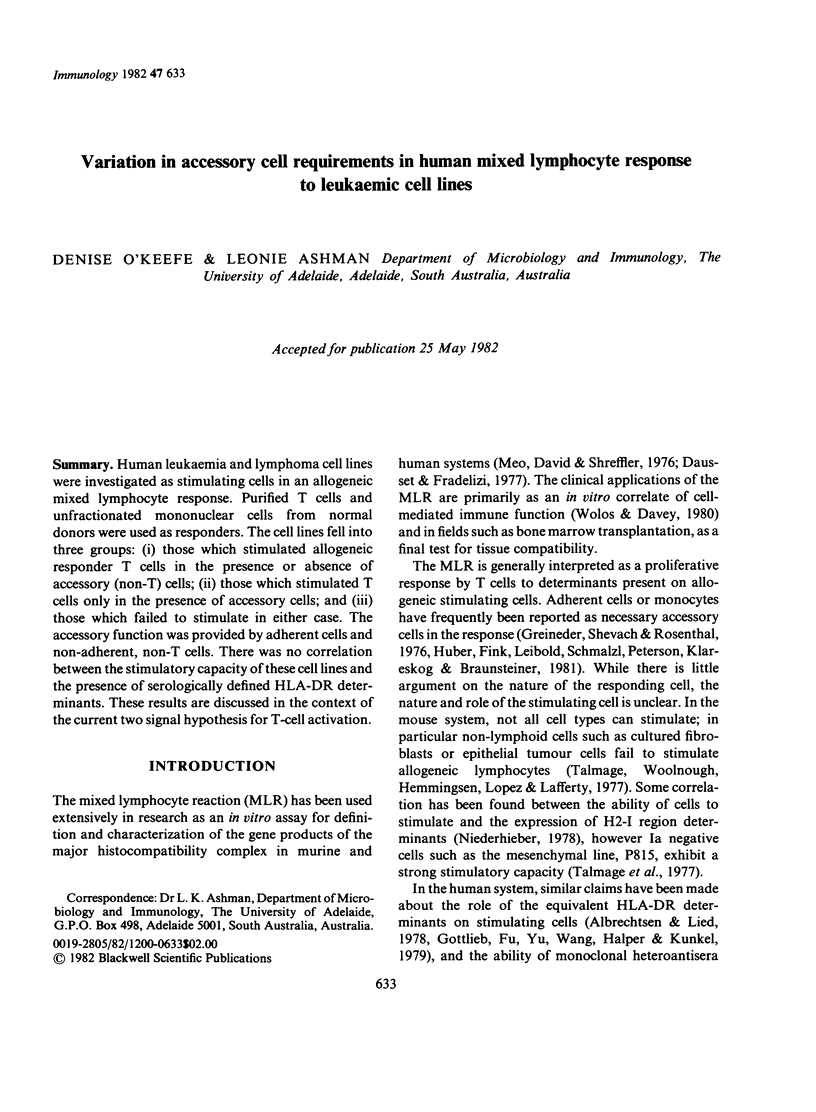
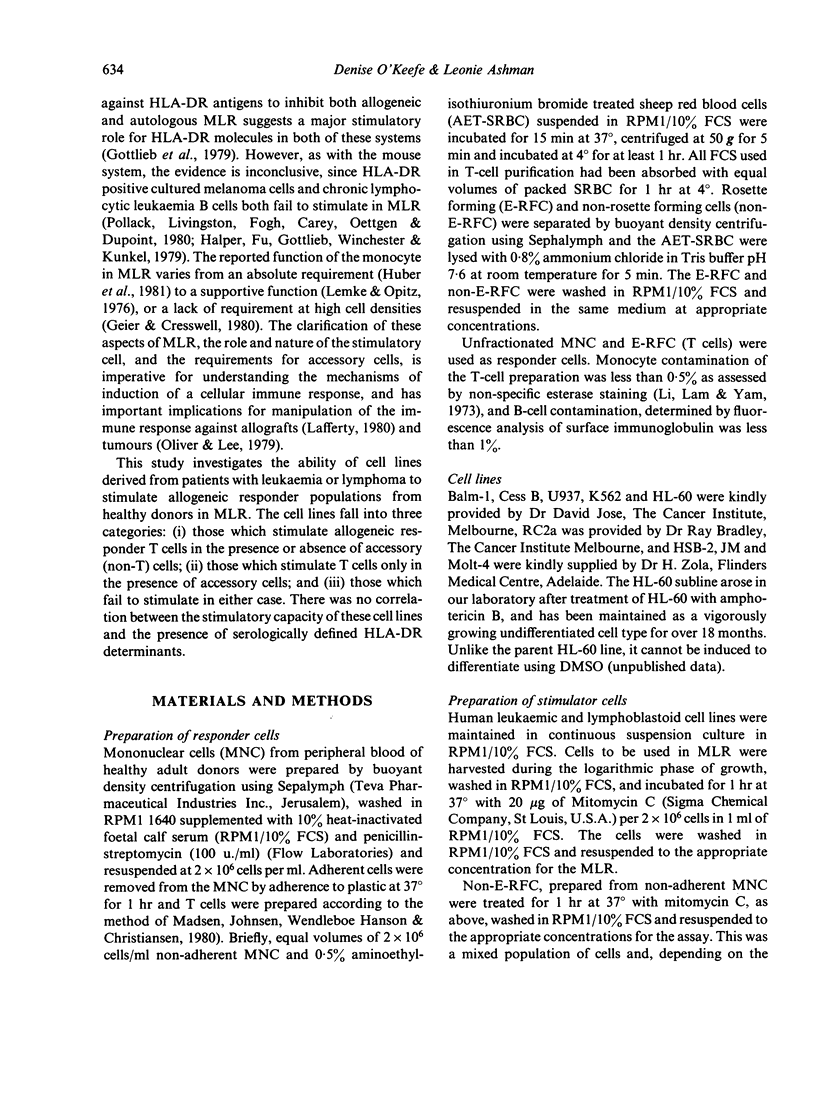
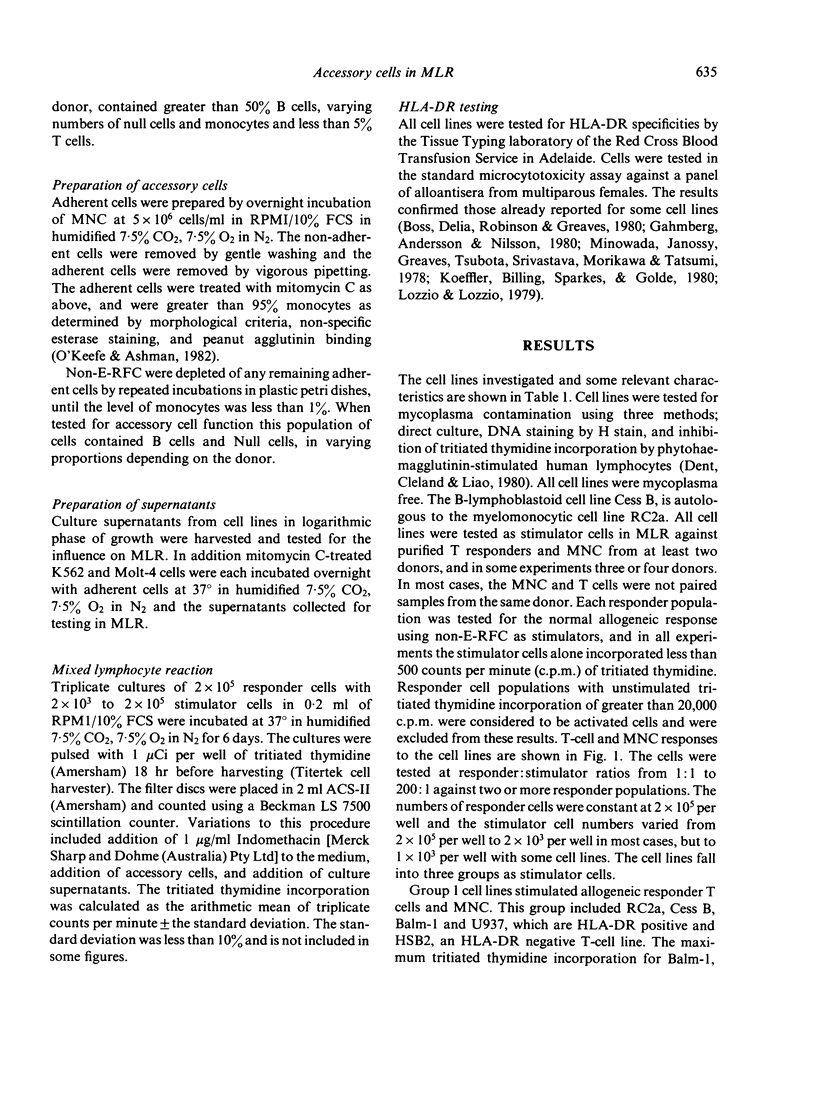
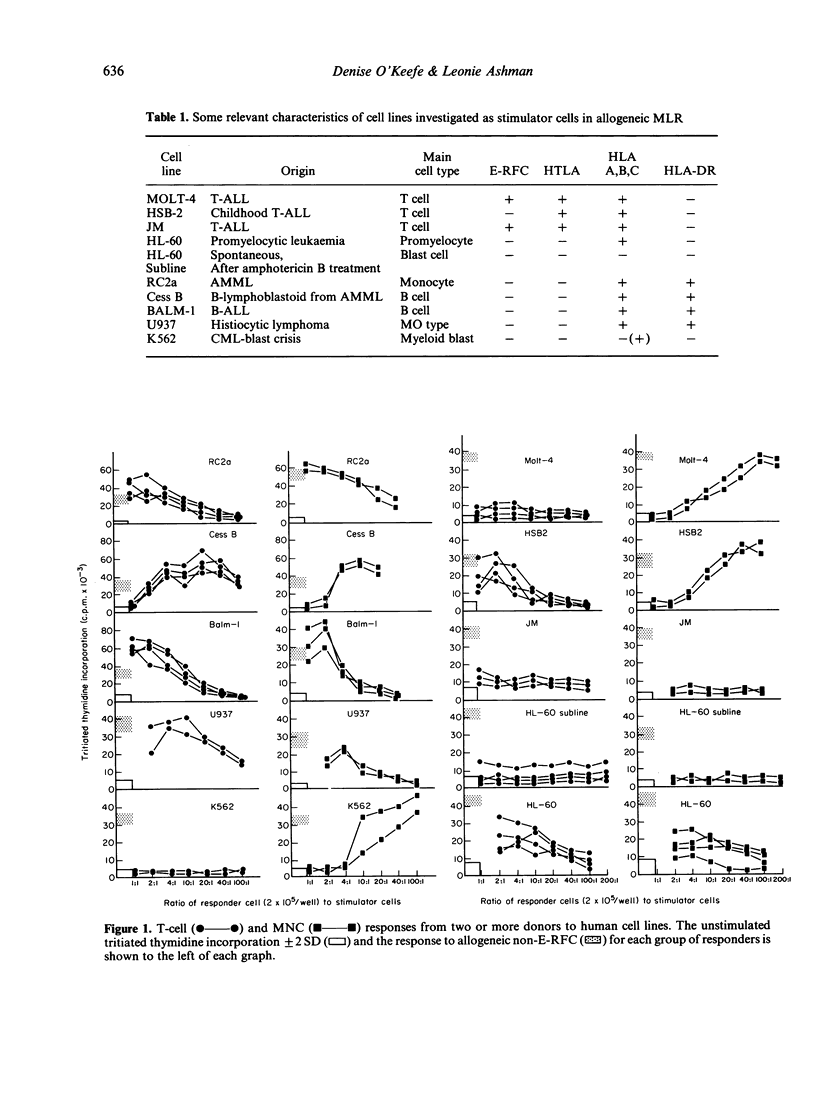
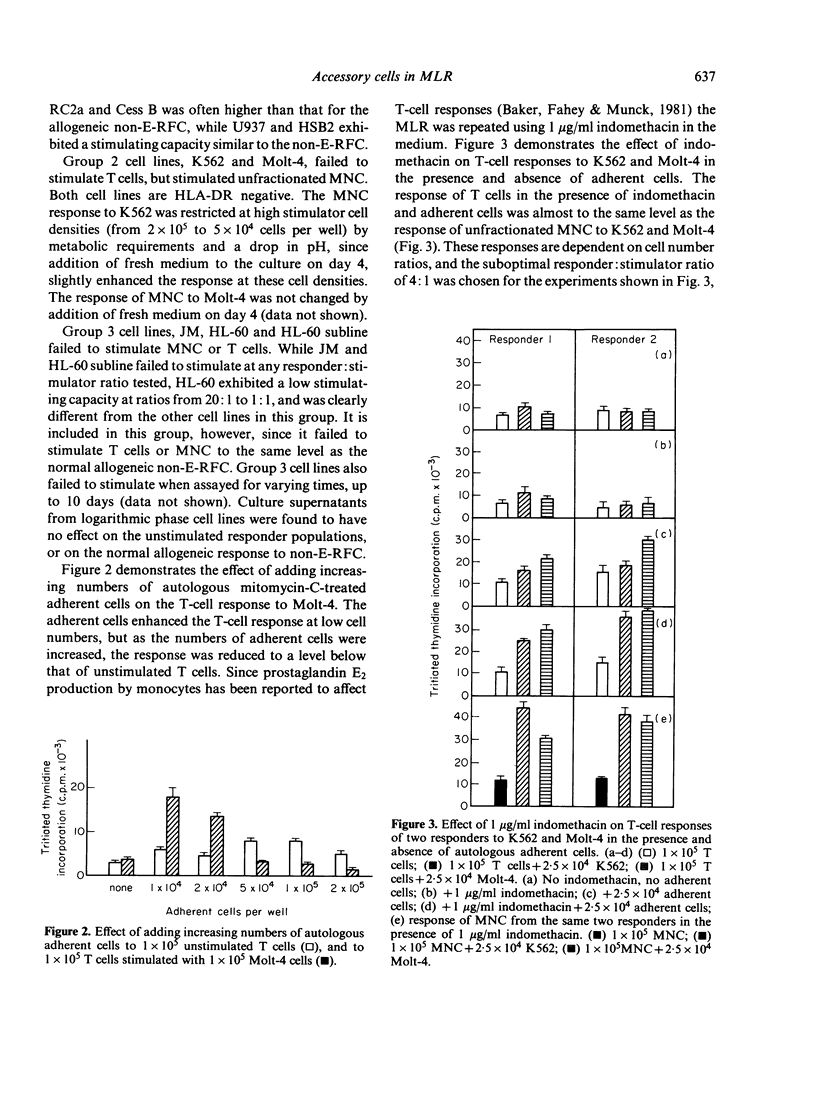
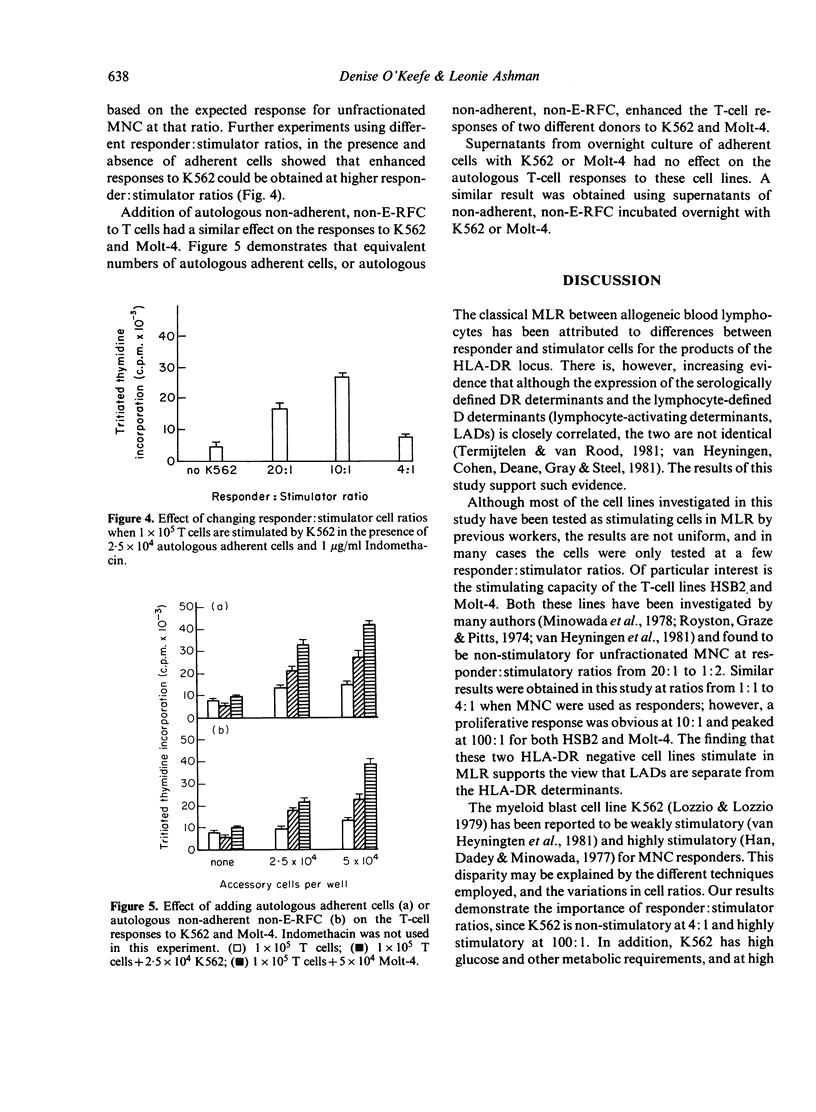
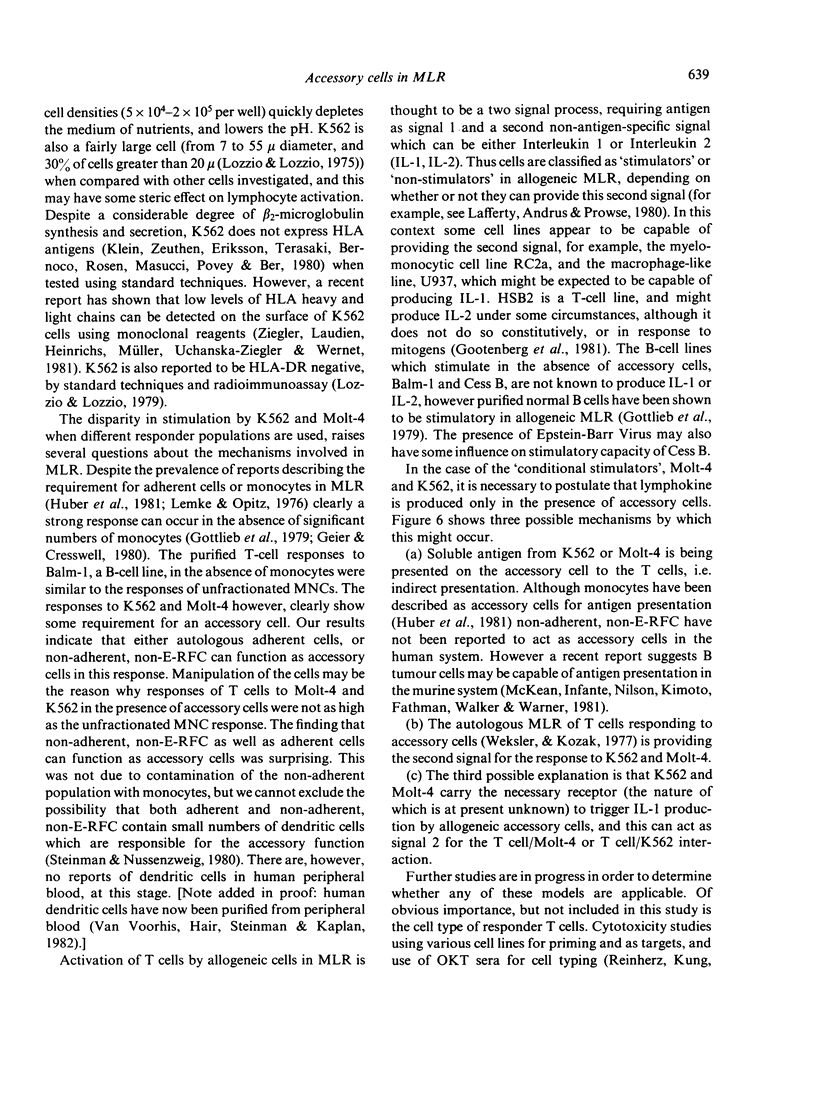
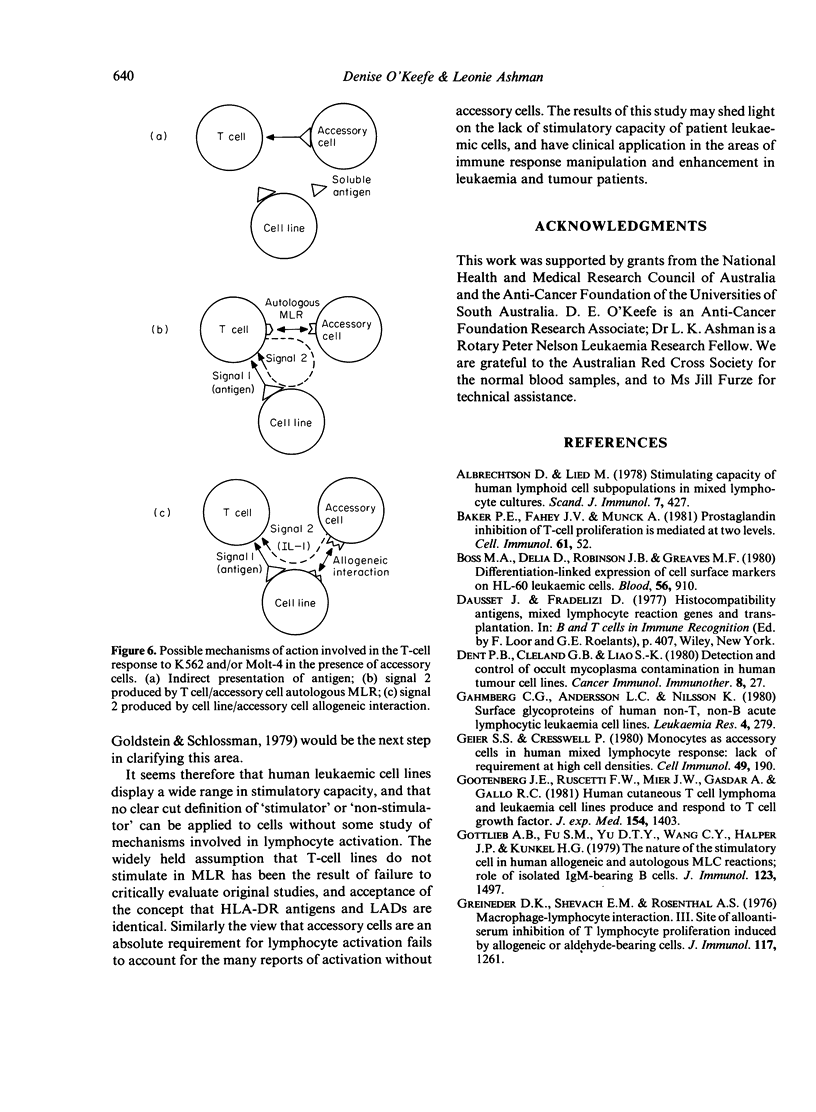
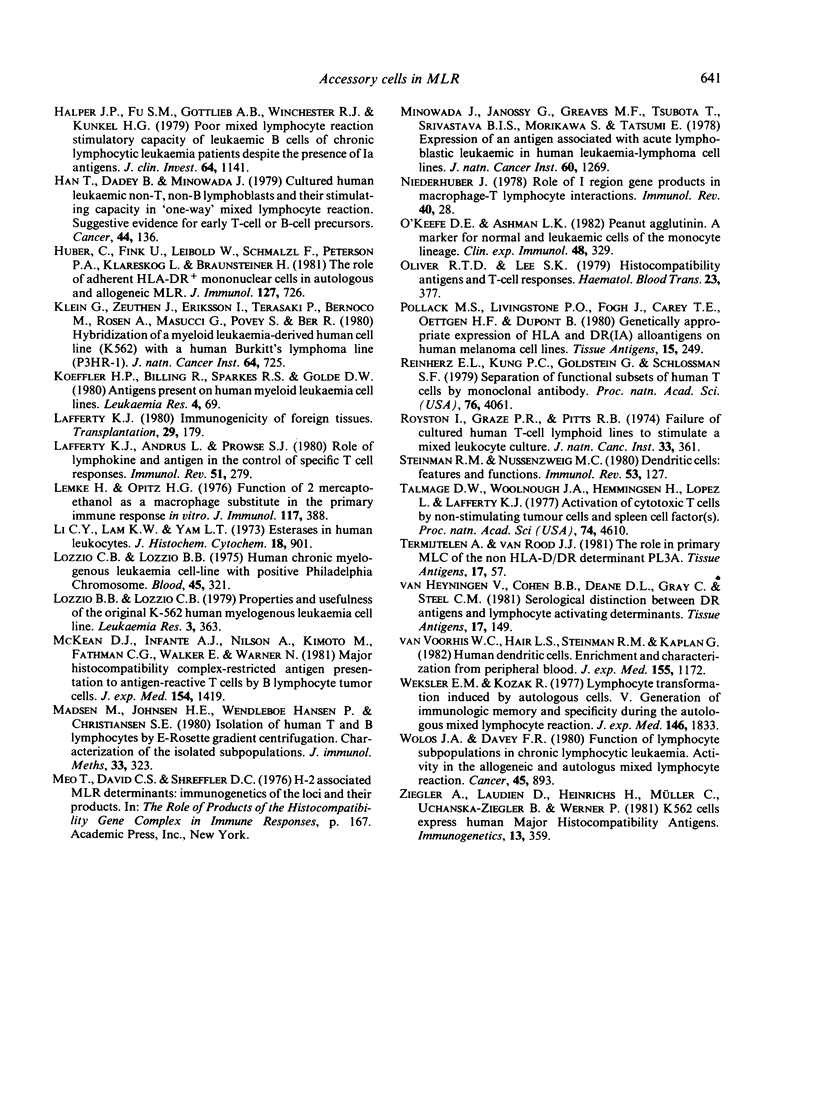
Selected References
These references are in PubMed. This may not be the complete list of references from this article.
- Albrechtsen D., Lied M. Stimulating capacity of human lymphoid cell subpopulations in mixed lymphocyte cultures. Scand J Immunol. 1978;7(5):427–434. doi: 10.1111/j.1365-3083.1978.tb00474.x. [DOI] [PubMed] [Google Scholar]
- Baker P. E., Fahey J. V., Munck A. Prostaglandin inhibition of T-cell proliferation is mediated at two levels. Cell Immunol. 1981 Jun;61(1):52–61. doi: 10.1016/0008-8749(81)90353-1. [DOI] [PubMed] [Google Scholar]
- Boss M. A., Delia D., Robinson J. B., Greaves M. F. Differentiation-linked expression of cell surface markers on HL-60 leukemic cells. Blood. 1980 Nov;56(5):910–916. [PubMed] [Google Scholar]
- Gahmberg C. G., Andersson L. C., Nilsson K. Surface glycoproteins of human non-T, non-B acute lymphocytic leukemia cell lines. Leuk Res. 1980;4(3):279–286. doi: 10.1016/0145-2126(80)90035-1. [DOI] [PubMed] [Google Scholar]
- Geier S. S., Cresswell P. Monocytes as accessory cells in the human mixed lymphocyte response: lack of requirement at high cell densities. Cell Immunol. 1980 Jan;49(1):190–195. doi: 10.1016/0008-8749(80)90068-4. [DOI] [PubMed] [Google Scholar]
- Gootenberg J. E., Ruscetti F. W., Mier J. W., Gazdar A., Gallo R. C. Human cutaneous T cell lymphoma and leukemia cell lines produce and respond to T cell growth factor. J Exp Med. 1981 Nov 1;154(5):1403–1418. doi: 10.1084/jem.154.5.1403. [DOI] [PMC free article] [PubMed] [Google Scholar]
- Gottlieb A. B., Fu S. M., Yu D. T., Wang C. Y., Halper J. P., Kunkel H. G. The nature of the stimulatory cell in human allogeneic and autologous MLC reactions; role of isolated IgM-bearing B cells. J Immunol. 1979 Oct;123(4):1497–1503. [PubMed] [Google Scholar]
- Greineder D. K., Shevach E. M., Rosenthal A. S. Macrophage-lymphocyte interaction. III. Site of alloantiserum inhibition of T lymphocyte proliferation induced by allogeneic or aldehyde-bearing cells. J Immunol. 1976 Oct;117(4):1261–1266. [PubMed] [Google Scholar]
- Halper J. P., Fu S. M., Gottlieb A. B., Winchester R. J., Kunkel H. G. Poor mixed lymphocyte reaction stimulatory capacity of leukemic B cells of chronic lymphocytic leukemia patients despite the presence of Ia antigens. J Clin Invest. 1979 Nov;64(5):1141–1148. doi: 10.1172/JCI109567. [DOI] [PMC free article] [PubMed] [Google Scholar]
- Han T., Dadey B., Minowada J. Cultured human leukemic non-T/non-B lymphoblasts and their stimulating capacity in "one-way" mixed lymphocyte reaction: suggestive evidence for early T-cell or B-cell precursors. Cancer. 1979 Jul;44(1):136–140. doi: 10.1002/1097-0142(197907)44:1<136::aid-cncr2820440124>3.0.co;2-i. [DOI] [PubMed] [Google Scholar]
- Huber C., Fink U., Leibold W., Schmalzl F., Peterson P. A., Klareskog L., Braunsteiner H. The role of adherent HLA-DR+ mononuclear cells in autologous and allogeneic MLR. J Immunol. 1981 Aug;127(2):726–731. [PubMed] [Google Scholar]
- Klein G., Zeuthen J., Eriksson I., Terasaki P., Bernoco M., Rosén A., Masucci G., Povey S., Ber R. Hybridization of a myeloid leukemia-derived human cell line (K562) with a human Burkitt's lymphoma line (P3HR-1). J Natl Cancer Inst. 1980 Apr;64(4):725–738. [PubMed] [Google Scholar]
- Koeffler H. P., Billing R., Sparkes R. S., Golde D. W. Antigens present on human myeloid leukemia cell lines. Leuk Res. 1980;4(1):69–77. doi: 10.1016/0145-2126(80)90047-8. [DOI] [PubMed] [Google Scholar]
- Lafferty K. J., Andrus L., Prowse S. J. Role of lymphokine and antigen in the control of specific T cell responses. Immunol Rev. 1980;51:279–314. doi: 10.1111/j.1600-065x.1980.tb00325.x. [DOI] [PubMed] [Google Scholar]
- Lafferty K. J. Immunogenicity of foreign tissues. Transplantation. 1980 Mar;29(3):179–182. [PubMed] [Google Scholar]
- Lemke H., Opitz H. G. Function of 2-mercaptoethanol as a macrophage substitute in the primary immune response in vitro. J Immunol. 1976 Aug;117(2):388–395. [PubMed] [Google Scholar]
- Li C. Y., Yam L. T., Lam K. W. Studies of acid phosphatase isoenzymes in human leukocytes demonstration of isoenzyme cell specificity. J Histochem Cytochem. 1970 Dec;18(12):901–910. doi: 10.1177/18.12.901. [DOI] [PubMed] [Google Scholar]
- Lozzio B. B., Lozzio C. B. Properties and usefulness of the original K-562 human myelogenous leukemia cell line. Leuk Res. 1979;3(6):363–370. doi: 10.1016/0145-2126(79)90033-x. [DOI] [PubMed] [Google Scholar]
- Lozzio C. B., Lozzio B. B. Human chronic myelogenous leukemia cell-line with positive Philadelphia chromosome. Blood. 1975 Mar;45(3):321–334. [PubMed] [Google Scholar]
- Madsen M., Johnsen H. E., Hansen P. W., Christiansen S. E. Isolation of human T and B lymphocytes by E-rosette gradient centrifugation. Characterization of the isolated subpopulations. J Immunol Methods. 1980;33(4):323–336. doi: 10.1016/0022-1759(80)90003-4. [DOI] [PubMed] [Google Scholar]
- McKean D. J., Infante A. J., Nilson A., Kimoto M., Fathman C. G., Walker E., Warner N. Major histocompatibility complex-restricted antigen presentation to antigen-reactive T cells by B lymphocyte tumor cells. J Exp Med. 1981 Nov 1;154(5):1419–1431. doi: 10.1084/jem.154.5.1419. [DOI] [PMC free article] [PubMed] [Google Scholar]
- Minowada J., Janossy G., Greaves M. F., Tsubota T., Srivastava B. I., Morikawa S., Tatsumi E. Expression of an antigen associated with acute lymphoblastic leukemia in human leukemia-lymphoma cell lines. J Natl Cancer Inst. 1978 Jun;60(6):1269–1277. doi: 10.1093/jnci/60.6.1269. [DOI] [PubMed] [Google Scholar]
- Niederhuber J. E. The role of I region gene products in macrophage - T lymphocyte interaction. Immunol Rev. 1978;40:28–52. doi: 10.1111/j.1600-065x.1978.tb00400.x. [DOI] [PubMed] [Google Scholar]
- O'Keefe D., Ashman L. Peanut agglutinin: a marker for normal and leukaemic cells of the monocyte lineage. Clin Exp Immunol. 1982 May;48(2):329–338. [PMC free article] [PubMed] [Google Scholar]
- Oliver R. T., Lee S. K. Histocompatibility antigens and T cell responses to leukemia antigens. Haematol Blood Transfus. 1979;23:377–379. doi: 10.1007/978-3-642-67057-2_48. [DOI] [PubMed] [Google Scholar]
- Pollack M. S., Livingston P. O., Fogh J., Carey T. E., Oettgen H. F., Dupont B. Genetically appropriate expression of HLA and DR (IA) alloantigens on human melanoma cell lines. Tissue Antigens. 1980 Mar;15(3):249–256. doi: 10.1111/j.1399-0039.1980.tb00915.x. [DOI] [PubMed] [Google Scholar]
- Reinherz E. L., Kung P. C., Goldstein G., Schlossman S. F. Separation of functional subsets of human T cells by a monoclonal antibody. Proc Natl Acad Sci U S A. 1979 Aug;76(8):4061–4065. doi: 10.1073/pnas.76.8.4061. [DOI] [PMC free article] [PubMed] [Google Scholar]
- Royston I., Graze P. R., Pitts R. B. Failure of cultured human T-cell lymphoid lines to stimulate in mixed leukocyte culture. J Natl Cancer Inst. 1974 Aug;53(2):361–367. doi: 10.1093/jnci/53.2.361. [DOI] [PubMed] [Google Scholar]
- Steinman R. M., Nussenzweig M. C. Dendritic cells: features and functions. Immunol Rev. 1980;53:127–147. doi: 10.1111/j.1600-065x.1980.tb01042.x. [DOI] [PubMed] [Google Scholar]
- Talmage D. W., Woolnough J. A., Hemmingsen H., Lopez L., Lafferty K. J. Activation of cytotoxic T cells by nonstimulating tumor cells and spleen cell factor(s). Proc Natl Acad Sci U S A. 1977 Oct;74(10):4610–4614. doi: 10.1073/pnas.74.10.4610. [DOI] [PMC free article] [PubMed] [Google Scholar]
- Van Voorhis W. C., Hair L. S., Steinman R. M., Kaplan G. Human dendritic cells. Enrichment and characterization from peripheral blood. J Exp Med. 1982 Apr 1;155(4):1172–1187. doi: 10.1084/jem.155.4.1172. [DOI] [PMC free article] [PubMed] [Google Scholar]
- Weksler M. E., Kozak R. Lymphocyte transformation induced by autologous cells. V. Generation of immunologic memory and specificity during the autologous mixed lymphocyte reaction. J Exp Med. 1977 Dec 1;146(6):1833–1838. doi: 10.1084/jem.146.6.1833. [DOI] [PMC free article] [PubMed] [Google Scholar]
- Wolos J. A., Davey F. R. Function of lymphocyte subpopulations in chronic lymphocytic leukemia. Activity in the allogeneic and autologous mixed lymphocyte reaction. Cancer. 1980 Mar 1;45(5):893–898. doi: 10.1002/1097-0142(19800301)45:5<893::aid-cncr2820450511>3.0.co;2-q. [DOI] [PubMed] [Google Scholar]
- Ziegler A., Laudien D., Heinrichs H., Müller C., Uchańska-Ziegler B., Wernet P. K562 cells express human major histocompatibility antigens. Immunogenetics. 1981;13(4):359–365. doi: 10.1007/BF00364503. [DOI] [PubMed] [Google Scholar]
- van Heyningen V., Cohen B. B., Deane D. L., Gray C., Steel C. M. Serological distinction between DR antigens and lymphocyte activating determinants. Tissue Antigens. 1981 Feb;17(2):149–161. doi: 10.1111/j.1399-0039.1981.tb00679.x. [DOI] [PubMed] [Google Scholar]


